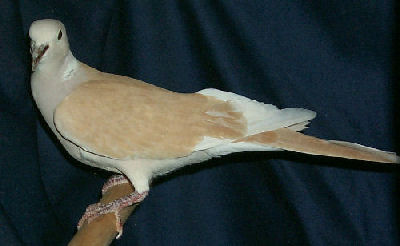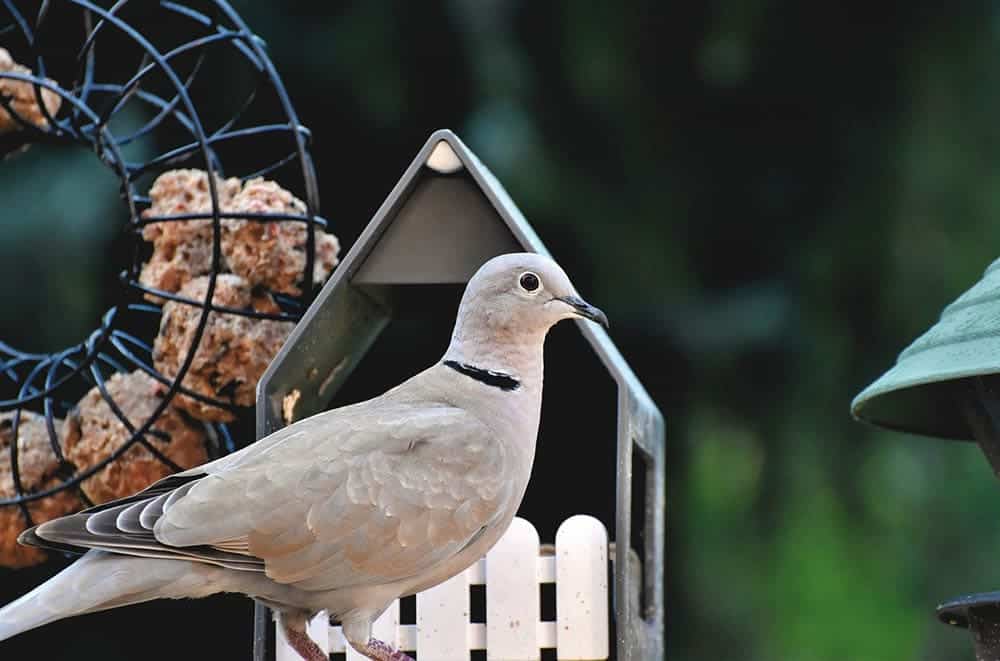
Ringneck Doves are gentle birds that do not bite and are easily tamed. They can be handled by by adults and children alike!
The Ringneck Dove is the surely the most commonly kept dove in captivity and are kept by fanciers all over the world. Ringneck Doves are easy to care for and are hardy. Being good-natured social creatures they will do well in either a cage or in an aviary and can be kept as a single bird or as a pair.
Perhaps best known for its gentle temperament, a Ringneck Dove makes a great pet that is sweet natured and almost naturally tame. Give it a couple days to get used to its new home and family, and then you can begin letting it out to explore its surroundings. Though your pet may flutter about for a bit when first let out, it will quickly settle down and become quite content.
Until the 1950’s only two colors of Ringneck Doves were available in the United States, a blond or fawn color and a white color known as the White Dove. Today the Ringneck Dove comes in over 40 colors with more being developed.
The Tangerine Ringneck Dove, like the one shown in the picture above, was the first color variation developed.
For more information about the care of Doves and Pigeons see:
Guide to a Happy, Healthy Doves & Pigeons.
- Kingdom: Animalia
- Phylum: Chordata
- Class: Aves
- Order: Columbiformes
- Family: Columbidae
- Genus: Streptopelia
- Species: risoria
Scientific Name:
Distribution:
There are seven species of ‘ringnecks’ and they are members of a group commonly called the Turtle Doves.
This domestic ringneck is classified as Streptopelia risoria. Although its true origin is unknown, the ringneck is generally thought to be descended from the African Ring Dove or African Collared Dove Streptopelia roseogrisea.
It had been kept for over 2000 years, brought to Europe in the second half of the sixteenth century from Sudan. Described by Linnaeus in 1756 as Columba risoria, it is only known to exist as a domesticated bird.
Description:
The Ringneck Dove is a small bird, about 12″ from head to tail. They will live an average 10 – 15 years, though some may live over 25 years.
Originally whites and blonds (fawns) were the only two known colors of Ringneck Doves in the United States. In the 1960’s breeders began experimenting and through selective breeding have developed a large number of varieties. Today there are over 40 color mutations/combinations acknowledged by Dove Associations and new color variations are emerging constantly. The first dominant gene caused color mutation was the tangerine.
Care and feeding:
Suitable housing for a Ringneck Dove would be a large cockatiel cage along with some flight time outside the cage. A pair can be kept and bred in a cage as small as 2 feet square. Cages that are longer and wider are more important than tall cages, as these birds flutter around and do not climb. Males tend to be quarrelsome with other males so keep pairs housed alone.
They are quite hardy. If they are kept outdoors and are accustomed to cold weather, they can take below freezing temperatures for a short period of time.
Ringneck Doves are very clean birds and love to bathe. They will enjoy either a bath in a large bowl of water or a shower, a misting with a light spray of clean water.
A commercial dove and pigeon mix or a regular parakeet seed mix supplemented with greens rich in minerals, vitamins, and calcium is a fine diet. Ringneck Doves love treats. They not only enjoy their greens, but will also enjoy spray millet and such things as crumbled cornmeal and bread. Grit is essential as Ringneck Doves swallow their food whole, and it helps grind up the food. Oyster shell or even cuttlebone can be added for calcium and is important for egg layers.
See About Doves & Pigeons: Housing and About Doves & Pigeons: Care and Feeding for more information.
Social Behaviors:
They are good-natured social creatures that do well when kept in cages or in aviaries. They can be rather territorial however, and will need plenty of personal space. They can be easily tamed with very little effort. They form permanent pairs and mates do well if kept together.
See About Doves & Pigeons: Social Behaviors for more information on social behaviors of doves and pigeons.
Activities:
If kept in a cage, they should be let out daily for some free time to exercise. They are not known to be strong fliers and will be content to just flutter here and there and then will quickly settle down.
Breeding/Reproduction:
Ringneck Doves are easy to breed, but are not usually community breeders unless there is a lot of room. They will do best in their own cage and it can be relatively small. They are rather flimsy nest builders so it is best to provide them with an open nesting container.
They can be bred as early as 6 months of age. They will lay two eggs which hatch after about 14 days. The young will stay in the nest for about 4 weeks or so. The parents can lay a new clutch of eggs every six weeks but this is very unhealthy for the birds. It is recommended that they only produce 3 to 5 clutches a year. You can remove the nesting materials or separate the birds to control this.
See About Doves & Pigeons: Breeding/Reproduction for more information on breeding.
Potential Problems:
These birds are hardy and healthy if provided with a good environment and a good diet. Avoid an environment that is wet, cool, and drafty.
See About Doves & Pigeons: Potential Problems for information on health.
Availability:
The Ringneck Doves are readily available. Usually available at pet stores, but can also be found through bird shows, bird clubs or breeders.
Featured Image Credit: Capri23auto, Pixabay
